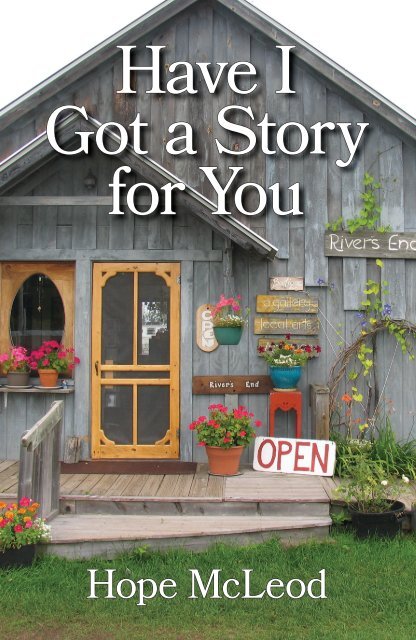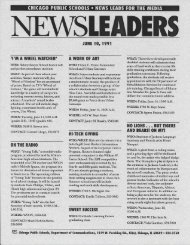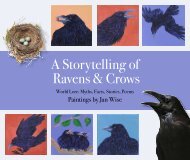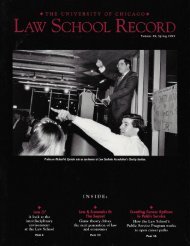You also want an ePaper? Increase the reach of your titles
YUMPU automatically turns print PDFs into web optimized ePapers that Google loves.
<strong>Have</strong> I<br />
<strong>Got</strong> a <strong>Story</strong><br />
<strong>for</strong> <strong>You</strong><br />
<strong>Hope</strong> <strong>McLeod</strong>
Praise <strong>for</strong> <strong>Have</strong> I <strong>Got</strong> a <strong>Story</strong> <strong>for</strong> <strong>You</strong><br />
Reading <strong>Have</strong> I <strong>Got</strong> a <strong>Story</strong> <strong>for</strong> <strong>You</strong> is like a wind-swept day of beachcombing <strong>—</strong><br />
a jewel of beach glass here, a water-carved rock there, an interesting twist of<br />
driftwood <strong>—</strong> until your pockets are full of treasures and stories. In this gem of<br />
a book, <strong>Hope</strong> <strong>McLeod</strong> masterfully weaves together the wave-tossed strands of<br />
humble heroism, hidden talent, boundless love, and just plain grit scrolled deep<br />
into the hearts and lives of the lake-charmed few who call this coast home. If<br />
stories are the threads that bind us together as a community, <strong>Hope</strong>’s book is the<br />
cleat hitch that holds us fast to this place and to each other.<br />
<strong>—</strong> Jeff Rennicke, author of Jewels on the Water: Lake Superior’s Apostle Islands and<br />
contributor to Backpacker, Reader’s Digest, and National Geographic Traveler<br />
v<br />
Good journalism is about finding truth. Across her years as a reporter <strong>for</strong> the<br />
Bayfield County Journal, <strong>Hope</strong> <strong>McLeod</strong> has found beautiful truths in many hidden<br />
places and shining in so many unlikely faces. This collection of some of her best<br />
articles offers stories of hope, courage, humor, sadness, and certainly wisdom.<br />
With luminous prose, a huge heart, and a journalist’s eye <strong>for</strong> detail, <strong>McLeod</strong> has<br />
created a treasure chest filled with people whose ordinary appearance masks<br />
extraordinary lives.<br />
<strong>—</strong> William Kent Krueger, New York Times bestselling author of the Cork O’Connor series<br />
v<br />
For someone with both passion and reverence <strong>for</strong> Lake Superior and <strong>for</strong><br />
authentic writing <strong>—</strong> the kind that honors place and the people who inhabit it <strong>—</strong><br />
<strong>Hope</strong> <strong>McLeod</strong>’s anthology, <strong>Have</strong> I <strong>Got</strong> a <strong>Story</strong> <strong>for</strong> <strong>You</strong>, is a gift.<br />
<strong>—</strong> Journalist Jacqui Banaszynski, winner of the Pulitzer Prize in feature writing<br />
v<br />
In these times of techno-tribalism, how grateful I am <strong>for</strong> chroniclers like<br />
<strong>Hope</strong> <strong>McLeod</strong> and the record she keeps of the quieter moments, quieter places,<br />
and quieter citizens. Here are the rewards of civility and civilization if we will<br />
keep them.<br />
<strong>—</strong> Michael Perry, New York Times bestselling author of Population: 485,<br />
Truck, Coop, Visiting Tom, and Montaigne in Barn Boots<br />
v<br />
Every community needs a storyteller, and in her new collection of stories from<br />
the Bayfield peninsula <strong>Hope</strong> <strong>McLeod</strong> grasps the role and runs with it. These<br />
are tales of artists and eccentrics, of life, love and occasional loss, of people<br />
searching <strong>for</strong> beauty or, in one case, <strong>for</strong> UFOs, characters all who together make<br />
up the rich fabric of life along the edge of Lake Superior.<br />
<strong>—</strong> Dennis McCann, <strong>for</strong>mer columnist <strong>for</strong> Milwaukee Journal Sentinel and author of<br />
This Superior Place: Stories of Bayfield and the Apostle Islands<br />
v<br />
<strong>Hope</strong>’s body of work with the Ashland Daily Press and the Bayfield County<br />
Journal on the arts, literature and music has been extraordinary, and greatly<br />
appreciated <strong>by</strong> the entire Chequamegon Bay community.<br />
<strong>—</strong> Theron O’Connor, owner of Apostle Islands <strong>Book</strong>sellers in Bayfield, Wisconsin
<strong>Have</strong> I<br />
<strong>Got</strong> a <strong>Story</strong><br />
<strong>for</strong> <strong>You</strong><br />
Stories & photographs from<br />
the South Shore of Lake Superior<br />
<strong>by</strong> <strong>Hope</strong> <strong>McLeod</strong><br />
Washburn, Wisconsin
<strong>Have</strong> I <strong>Got</strong> a <strong>Story</strong> <strong>for</strong> <strong>You</strong><br />
Copyright © 2018 <strong>Hope</strong> <strong>McLeod</strong><br />
ISBN 978-0-692-18718-0<br />
Published in November 2018 <strong>by</strong><br />
Herd a Word<br />
Washburn, Wisconsin<br />
hopemcleod3@gmail.com<br />
http://www.hopemcleod.com<br />
Graphic <strong>Design</strong>: Catherine Lange<br />
Editing: Paul Mitchell & <strong>Hope</strong> <strong>McLeod</strong><br />
Cover photo: <strong>Hope</strong> <strong>McLeod</strong><br />
Photographs: Unless otherwise noted, all photographs <strong>by</strong> <strong>Hope</strong> <strong>McLeod</strong><br />
All rights reserved. This book, or parts thereof, may not be used or<br />
reproduced in any <strong>for</strong>m without permission of the author, except <strong>by</strong> a<br />
reviewer, who may quote brief passages <strong>for</strong> a review.<br />
Other books <strong>by</strong> <strong>Hope</strong> <strong>McLeod</strong>:<br />
The Place We Begin (2012)
Aunt Cara<br />
(March 3, 1871– January 22, 1956)<br />
Gratitude to all my angels both past and present, most<br />
especially to Caroline Dale Snedeker, aka Aunt Cara,<br />
author of 14 young adult historical fiction books. Not only<br />
did this great aunt of mine feed my hungry imagination<br />
as a child, she also helped feed this book <strong>by</strong> delivering<br />
occasional royalty checks from her distant cloud.
Contents<br />
Preface . . . . . . . . . . . . . . . . . . . . . . . . . . . . . . . . . . ix<br />
Introduction . . . . . . . . . . . . . . . . . . . . . . . . . . . . . . . xi<br />
1. Smelt on the run. . . . . . . . . . . . . . . . . . . . . . . . . . . . . 1<br />
2. Rescue mission in the fog . . . . . . . . . . . . . . . . . . . . . . . .4<br />
3. A guided walk in Bayfield Cemetery . . . . . . . . . . . . . . . . . . 8<br />
4. Water-themed photography (Marc Wanvig) . . . . . . . . . . . . . . 11<br />
5. Bailey’s Greenhouse (Renewable energy) . . . . . . . . . . . . . . 14<br />
6. Local flutemaker wins Wisconsin Folk Arts award<br />
(Frank Montano, Native American flute maker & player) . . . . . . 19<br />
7. Ashland artist makes a big splash (Leonarda Boughton) . . . . . . 22<br />
8. Gone viral (Ice Caves in Cornucopia, Wisconsin) . . . . . . . . . . 26<br />
9. Ice Cave inspiration doesn’t melt <strong>for</strong> artists<br />
(Jeff Rennicke, photographer) . . . . . . . . . . . . . . . . . . . . . 30<br />
10. Women farmers step up to the plow<br />
(Dr. Claire Hintz from Elsewhere Farm) . . . . . . . . . . . . . . . 34<br />
11. UFO researcher is open <strong>for</strong> business (Alan B. Smith) . . . . . . . 38<br />
12. The Missing Houses of Washburn (History mystery) . . . . . . . . 42<br />
13. Behind every lamppost there’s a stellar player<br />
(Alex Blaine, saxophonist) . . . . . . . . . . . . . . . . . . . . . . . 46<br />
14. The lake takes care of everyone<br />
(Tribute to Jim Stonehouse Hudson). . . . . . . . . . . . . . . . . 50<br />
15. Former dancer Kelsey Peterson raises the barre<br />
on spinal cord injuries. . . . . . . . . . . . . . . . . . . . . . . . . 54<br />
16. Ahead of the wave (Tom Blake, record-breaking<br />
surfer/inventor from Washburn) . . . . . . . . . . . . . . . . . . . . 58<br />
17. Through the artist’s eyes<br />
(Derek Lusche, vision-impaired artist). . . . . . . . . . . . . . . . 63<br />
18. Lori Schneider empowers others to climb beyond their limits<br />
(A mountain climber with MS) . . . . . . . . . . . . . . . . . . . . 66<br />
vi<br />
<strong>Have</strong> I <strong>Got</strong> a <strong>Story</strong> <strong>for</strong> <strong>You</strong>
19. Raising awareness through the art of nature and<br />
the nature of art (Jim Ramsdell, woodcarver). . . . . . . . . . . . 70<br />
20. UHEAL adds a rescued draft horse to its herd<br />
of therapy horses . . . . . . . . . . . . . . . . . . . . . . . . . . . . 74<br />
21. Has Rocky Run run its course? (Don Ekstrom). . . . . . . . . . . 77<br />
22. Our Sally (Tribute to a beloved junk collector) . . . . . . . . . . . . 81<br />
23. John Hanson’s earlier films are having second lives<br />
(An Academy award-winning filmmaker) . . . . . . . . . . . . . . . 85<br />
24. Washburn native Marlin Ledin celebrates new CD . . . . . . . . . 89<br />
25. Pigs in peril survive big storm . . . . . . . . . . . . . . . . . . . . . 93<br />
26. Sitbon thinks outside the box (Painter/muralist) . . . . . . . . . . . 96<br />
27. Fostering leads to adoption <strong>for</strong> Mettille family<br />
(Same sex couple) . . . . . . . . . . . . . . . . . . . . . . . . . . . 101<br />
28. Relics from Mary Carlson’s yard turned into a book<br />
(Early Bayfield history) . . . . . . . . . . . . . . . . . . . . . . . . 105<br />
29. Retired maître d’ <strong>for</strong> Wild Rice spends<br />
more time sculpting (Randy Anderson) . . . . . . . . . . . . . . . 109<br />
30. Washburn students help plant White House garden . . . . . . . . 113<br />
31. Peace Violin gifted to young violinist . . . . . . . . . . . . . . . . 117<br />
32. Raising the rafters at the DuPont Civic Center<br />
(Washburn history) . . . . . . . . . . . . . . . . . . . . . . . . . . 122<br />
33. Local storyteller/dancer teaches ‘Dancing the Season<br />
in Spring’ (Regina Laroche) . . . . . . . . . . . . . . . . . . . . . 126<br />
34. Brother and sister put art and books toward a good cause . . . . 130<br />
35. New bells are ringing in Washburn<br />
(Jesse Woodward, repurposed metal sculptor) . . . . . . . . . . . 133<br />
Epilogue . . . . . . . . . . . . . . . . . . . . . . . . . . . . . . . . 137<br />
Acknowledgments . . . . . . . . . . . . . . . . . . . . . . . . . . . 139<br />
About the Author . . . . . . . . . . . . . . . . . . . . . . . . . . . 140<br />
Contents<br />
vii
Preface<br />
By Paul Mitchell<br />
Newspaper reporters are a breed apart, often as unique and quirky as<br />
the subjects of their best stories. After two decades as a newspaper editor,<br />
I thought I’d seen them all.<br />
And then I met <strong>Hope</strong> <strong>McLeod</strong>.<br />
In 2013 I left my office-bound position to work from home both as an<br />
online editor and as editor and designer <strong>for</strong> the Bayfield County Journal.<br />
I found it to be an entertaining and enlightening paper, with well-written<br />
and engaging community columns filling its inside pages. The meat of<br />
the paper, however, was the front-page stories written <strong>by</strong> “reporter” <strong>Hope</strong><br />
<strong>McLeod</strong>.<br />
I put the word reporter in parentheses in <strong>Hope</strong>’s case because, as<br />
you will discover in these pages, <strong>Hope</strong> <strong>McLeod</strong> is not your usual reporter.<br />
<strong>Hope</strong> is an artist who uses her talent <strong>for</strong> wordsmithing to bring to life<br />
the stories that make her community so unique, so diverse and so<br />
culturally rich.<br />
In news writing, we often have to “crank it out” to meet deadlines. We<br />
conduct interviews, take photographs, make phone calls and do a little<br />
research, and then we grab the keyboard and tap the stories out as quickly<br />
as we can to make deadline. Stories are written <strong>for</strong> this week’s paper, to<br />
engage and enlighten the reader <strong>for</strong> a time. <strong>Hope</strong>fully they’re well read<br />
be<strong>for</strong>e they end up at the bottom of the birdcage.<br />
Some stories, however, require extra care and extra crafting. We<br />
spend more time writing and researching. We tweak and edit and rewrite.<br />
We get second opinions, we do follow-up interviews and we obsess a bit.<br />
These are the stories we remember long after they’re finished.<br />
In <strong>Hope</strong>’s case, every story is treated this way. Every story is a special<br />
event. Every story is a tale <strong>for</strong> the ages. For starters, <strong>Hope</strong> goes beyond<br />
in<strong>for</strong>mation gathering to really get to know her subjects. She listens and<br />
photographs with care and with empathy. Once <strong>Hope</strong> begins writing, she<br />
chooses every word and every phrase with meticulous care, reaching into<br />
her background as a poet and songwriter to create stories that sing from<br />
the page.<br />
The year that I spent working with <strong>Hope</strong> was a difficult one in my own<br />
life. My son was recovering from a devastating spinal cord injury and we<br />
were traveling to the Twin Cities <strong>for</strong> therapy constantly. And during that<br />
year I had a recovery of my own after a minor heart attack. Instead of being<br />
work, editing <strong>Hope</strong>’s stories was a respite. She has a unique talent <strong>for</strong><br />
viii<br />
<strong>Have</strong> I <strong>Got</strong> a <strong>Story</strong> <strong>for</strong> <strong>You</strong>
finding people whose tales inspire and encourage the rest of us to endure<br />
our own trials, to be true to our values and to reach <strong>for</strong> our dreams.<br />
Working with <strong>Hope</strong> was a new experience <strong>for</strong> me. When <strong>Hope</strong> turned<br />
in a story, it was the beginning of a process of give and take, of crafting<br />
and polishing. I would make suggestions; she would build on them or<br />
come up with new ideas. There would be a flurry of emails, and often my<br />
phone would ring be<strong>for</strong>e I’d even had a chance to open them. “Paul, have<br />
you read my emails yet? Here’s what I’m thinking…”<br />
For <strong>Hope</strong>, a story is never finished until it’s on the page and printed,<br />
and sometimes not even then. There were times she’d call and ask me to<br />
change something in the online version. Too late <strong>for</strong> print, she’d say, but….<br />
Working with <strong>Hope</strong> is challenging and fulfilling. Through each story<br />
I found the opportunity to be inspired and to grow. Her job was never an<br />
easy one, and I’m glad I was able to offer her encouragement and a sympathetic<br />
ear when necessary, as she did <strong>for</strong> me.<br />
Over the years I’ve heard many reporters and columnists say they’d<br />
like to combine their stories in book <strong>for</strong>m. I smile, I nod, and I think to<br />
myself, “Good lord. Don’t do it.”<br />
News is written to be timely, not timeless.<br />
When <strong>Hope</strong> told me she wanted to put her stories in book <strong>for</strong>m, I<br />
thought to myself, “What a great idea.”<br />
By combining this selection of stories, <strong>Hope</strong> has created a volume<br />
that community members will cherish, one that paints a portrait of life in<br />
one of the most unique communities in the Midwest. With this book, the<br />
recent history of the Bayfield peninsula is literally at your fingertips. It’s<br />
not the history of mayhem and meetings and events that often populates<br />
the front page of newspapers. It’s the history of a community as seen and<br />
heard through the eyes and words of the people who live in it, who make<br />
the Bayfield peninsula a one-of-a-kind Wisconsin treasure.<br />
Even though <strong>Hope</strong> has left her position at the newspaper, her role as<br />
storyteller and documentarian of her community will continue and will<br />
endure.<br />
And we’re all the richer <strong>for</strong> it. v<br />
Paul Mitchell<br />
Publisher/Managing Editor<br />
Sawyer County Record, Hayward, Wisconsin<br />
Preface ix
Introduction<br />
By <strong>Hope</strong> <strong>McLeod</strong><br />
<strong>Have</strong> I <strong>Got</strong> a <strong>Story</strong> <strong>for</strong> <strong>You</strong> is a collection of 35 feature stories I wrote<br />
<strong>for</strong> the Bayfield County Journal (BCJ) between 2012-2017. Though previously<br />
published in this Northern Wisconsin newspaper, also its sister paper,<br />
the Ashland Daily Press (ADP), these stories have been newly edited<br />
to give them a longer shelf life. Paul Mitchell, my <strong>for</strong>mer editor <strong>for</strong> the BCJ<br />
from 2013-2014, helped me do the honors. Mitchell taught me practically<br />
everything I know about good journalism. So if you have any complaints,<br />
blame him. (Only joking.) That’s another thing he taught me: how not to<br />
take myself, or my work, so seriously, which I do.<br />
During my tenure at the paper, which ended on December 24, 2017,<br />
I penned 749 stories. I also took thousands of photographs. Obviously I<br />
had to leave a few out of this collection. Selecting content <strong>for</strong> the book<br />
took two hyperventilating months, during which time I received excellent<br />
CPR from Demaris Brinton, co-owner of the Apostle Islands <strong>Book</strong>sellers<br />
in Bayfield.<br />
“Choose stories that surprise you,” she advised, “ones that pop, and<br />
show off the uniqueness and diversity of the characters living in this<br />
region.” Her point was that if a New Yorker walks into the bookstore, why<br />
should they care about Podunk, Wisconsin? Here’s why.<br />
Margaret Wheatley, an American writer and management consultant,<br />
said recently that what we need as a society is to create “islands of<br />
sanity” <strong>—</strong> respites from the challenges we face on a currently overcrowded<br />
and stressed-out planet. As a reporter I discovered many islands<br />
of sanity along the South Shore of Lake Superior, my beat <strong>for</strong> six years.<br />
Though not all of neelthem good news stories, the ones I’ve chosen <strong>for</strong><br />
this collection share several distinct qualities: heroism, resilience, and<br />
heartbreakingly beautiful responses to an environment that both giveth<br />
and taketh away.<br />
It’s not easy living in Northern Wisconsin with its occasional polar<br />
vortex and short growing season. But the people who choose to live here<br />
have adapted to their tough surroundings in unique ways, like creating<br />
gardens of Eden out of hard clay soil or bell sculptures fashioned out<br />
of recycled CO2 oxygen tanks <strong>—</strong> two subjects in this book. Following<br />
Demaris’s lead, I chose the most unique characters I could find.<br />
Why a book of stories previously published? Two reasons: one, I<br />
wanted to provide a keepsake <strong>for</strong> the community, something to pass onto<br />
the next generation. Two, I wanted to inspire strangers who randomly<br />
x<br />
<strong>Have</strong> I <strong>Got</strong> a <strong>Story</strong> <strong>for</strong> <strong>You</strong>
walk into the bookstore to pick up my book and find they can’t put it down<br />
once discovering people like mountaineer Lori Schneider, who despite<br />
MS, has summited the seven tallest mountains in the world. These stories<br />
need to be shared with a wider audience, if nothing else, to say to readers,<br />
“If Lori can do this, I can.”<br />
Once I wrote a piece about author Tom Vennum, <strong>for</strong>mer Senior<br />
Ethnomusicologist Emeritus <strong>for</strong> the Smithsonian Institution. Vennum<br />
summered on Madeline Island and wrote several books on Ojibwe music<br />
and culture. In one of them he referred to the traditional birch bark canoe,<br />
still built <strong>by</strong> the Anishinaabe in the region: “…ingeniously shaped, and<br />
sewed together with roots of the tamarack…They are water-tight and ride<br />
upon the water as light as a cork.” I like to think of these stories as little<br />
watertight boats floating down the river of time that can be picked up <strong>by</strong><br />
curious hands wondering where these vessels came from and what can<br />
be learned from them.<br />
Many people have asked how I got into journalism. First reason is<br />
my mother, <strong>for</strong>mer art columnist <strong>for</strong> the New Mil<strong>for</strong>d Times, a small<br />
weekly newspaper in Connecticut where I grew up. I often accompanied<br />
her on interviews with famous artists, such as mobile inventor, Sandy<br />
Calder, sculptor, Henry Moore, or historic barn painter, Eric Sloane.<br />
Bigger-than-life characters, their stories left a big impression on me.<br />
But I didn’t pursue journalism right away. Instead I became a professional<br />
singer/songwriter <strong>for</strong> over 30 years. Like a broadside balladeer, I documented<br />
and crooned the accounts of interesting people’s lives and events<br />
encountered wherever I lived <strong>—</strong> Connecticut, Colorado, Europe, Cali<strong>for</strong>nia,<br />
and Wisconsin.<br />
I moved to Wisconsin in 1990 with T. Bruce Bowers, now my husband<br />
but also my <strong>for</strong>mer producer. We met in Cali<strong>for</strong>nia, where he<br />
helped usher in my first solo recording, “Time to Dream,” and later in<br />
Wisconsin a second one, “Frozen in Time.” Bruce has been the fiddler<br />
<strong>for</strong> the Lake Superior Big Top Chautauqua in Bayfield <strong>for</strong> over 35 years.<br />
That first summer I fell in love with the tent, and Warren Nelson’s history-based<br />
musicals. I eventually became a cast member in two house<br />
shows and per<strong>for</strong>med a solo concert each year. I also toured throughout<br />
the U.S. solo, or in duos and trios. In 1997 I wrote and produced my first<br />
history-inspired musical, “Frozen in Time,” featuring stories and songs<br />
about unique women in the region. Funded <strong>by</strong> the Wisconsin Sesquicentennial<br />
Commission to celebrate the state’s 150-year birthday in 1998,<br />
this journey awakened the journalist in me, as I conducted interviews,<br />
researched and deep-listened to countless stories. After some health challenges,<br />
I quit music and became a full time journalist in 2012. The rest is<br />
history written down in this book. I hope you enjoy reading these stories<br />
as much as I enjoyed writing them. v<br />
Introduction xi
xii<br />
<strong>Have</strong> I <strong>Got</strong> a <strong>Story</strong> <strong>for</strong> <strong>You</strong>
Lifetime smelter Louis Huesmann from Center City, Minnesota, waits patiently <strong>by</strong> his<br />
drop net at Bayview Park in Ashland on April 7, 2012.<br />
1.<br />
Smelt on the run<br />
4/12/12<br />
“Smelt on the Run” was my first story <strong>for</strong> the Bayfield County Journal.<br />
Eager to please my new boss, <strong>for</strong>mer editor Wanda Moeller, I hyperdedicated<br />
myself to the task at hand: following the annual smelt<br />
migration. Bibbed, polar-fleeced and slickered, I spent an entire week<br />
shivering next to a cult of smelters camped out along the South Shore<br />
of Lake Superior <strong>for</strong> several weeks in April. I have to admit, this was<br />
no July clambake like I’d grown up with in New England. Though<br />
locals called it spring, the zero temps and occasional snow flurries I<br />
experienced contradicted their claim. Nonetheless, being my virgin story,<br />
I was thrilled to be included in this unique, shivering circle of fisherfolk.<br />
Smelt on the run 1
Everyone has their theories but, “Smelt do what they want,” said Zack<br />
Jurewicz from Anglers All, a popular bait shop in Ashland.<br />
What this three-ounce, seven to nine-inch long, rainbow-sided trickster<br />
wants to do is reproduce. And what anglers want to do is catch them,<br />
which is easier said than done <strong>—</strong> especially this month.<br />
“At one time you could easily fill a pick-up truck in a few hours,” reported<br />
Lake Superior Charters.<br />
But that was back in the 1960s be<strong>for</strong>e the weather changes, like ice<br />
melting in March, <strong>for</strong> instance, instead of April.<br />
Ordinarily content in the deeper, darker waters of Lake Superior,<br />
rainbow smelt (Osmeros mordax) usually migrate to warmer shallows to<br />
spawn <strong>for</strong> one week anytime between April 1 and May 1, after ice melt<br />
and when surface temps have risen to at least 42 degrees. <strong>You</strong> may have<br />
noticed dozens of anglers huddled around campfires up and down the<br />
coast from Port Wing to Ashland this month, like they’ve done <strong>for</strong> the last<br />
70 years, ever since this non-native species was introduced to the Great<br />
Lakes in 1928.<br />
Officially the season opened April 1, yet due to earlier-than-usual ice<br />
melt, harvesters have been casting their nets since the end of March. The<br />
only ones who haven’t heard about the news are the smelt.<br />
Louis Huesmann from Center City, Minnesota has smelted his entire<br />
life. He came to Ashland last year from April 14-24 and caught “more than<br />
anyone would want,” but so far this year he’s only harvested a lamprey eel<br />
and four smelt. Hardly enough to feed his family, unless you like Frenchsized<br />
servings.<br />
“Had some misin<strong>for</strong>mation from our contacts, which brought us up a<br />
little earlier,” grumbled Huesmann.<br />
Along with a clutch of RV campers, he has been roosting with his wife<br />
and in-laws since March 29th at Bayview Park in Ashland, waiting <strong>for</strong><br />
smelt school to be let out. Every night he sets up his wind break on the<br />
dock so he and his family don’t get blown over <strong>by</strong> the monstrous northeast<br />
winds. Because of three knee surgeries, he no longer uses the traditional<br />
seine nets cast from shore and hauled in <strong>by</strong> hand repeatedly over the<br />
course of an evening. Instead, he lowers a drop net from the dock.<br />
“Frame’s made of spring steel. Looks like a pup tent with no sides,”<br />
he said.<br />
Huesmann sits in his portable chair with his wife and mother-in-law,<br />
and lifts the net out every few minutes after sundown. But why not just go<br />
home since the fish haven’t run in the last 12 days?<br />
“Because it’s fun, and we’ve made a lot of new friends. It’s really just<br />
one happy community,” he said.<br />
2 <strong>Have</strong> I <strong>Got</strong> a <strong>Story</strong> <strong>for</strong> <strong>You</strong>
Of course, they’d be a lot happier with some fish to fry.<br />
Smelt is a matter of taste, said Huesmann, who loves this fishy fish.<br />
“It’s like fish-flavored French fries. Fry ‘em up and swallow ‘em down<br />
whole,” he chuckled.<br />
Gail Bodin, a member of the renowned Bodin fishing family from<br />
Bayfield, recalls from her childhood, “First we took the heads off, then cut<br />
them open. Didn’t bother scaling and we always left their tails on,” after<br />
which her family dipped the critters in beer batter and cornmeal<br />
and tossed them into the campfire fry pan.<br />
Though not as popular as it once was, there’s also another ritual<br />
related to smelt consumption.<br />
“Fishermen are a superstitious lot,” says Peter Stevens from the<br />
Bayfield Fish Hatchery.<br />
For good luck, he said, rookie smelters are expected to bite the heads<br />
off of their first catch.<br />
“I could never do that,” said Ms. Bodin, puckering her lips.<br />
What she could do, however, was party hearty, along with everyone<br />
else in the region, geared up to celebrate this end-of-winter family<br />
tradition.<br />
“Cars would be lined up on both sides of the highway at Bayview<br />
Beach, also Sandbar Beach in Ashland, behind the <strong>for</strong>mer Bodin’s sport<br />
store,” she said. “Smelters peppered the shoreline.”<br />
Bodin’s cousin Jeff recalled, “The store stayed open until 2 a.m. some<br />
nights, selling hats, nets <strong>—</strong> whatever people needed <strong>—</strong> even smelt if it<br />
rained, so disappointed anglers didn’t go home hungry.”<br />
Commercial fishermen have always had the advantage over recreational<br />
smelters in that they spread huge trawling nets further out, in<br />
the middle of the lake, where smelt live the rest of the year. They also<br />
post-pound nets close to shore, on lines about six feet out from several<br />
docks in the region. Luckily, this year both Bodin Fisheries in Bayfield and<br />
Halverson’s in Cornucopia have been catching plenty of smelt, enough <strong>for</strong><br />
the Herbster’s Annual Smelt Fry on April 14.<br />
As <strong>for</strong> the recreational smelters? Well, they’re still waiting, as frigid<br />
breezes blow and temps go down to freezing at night. Nonetheless, it’s<br />
beautiful underneath the stars, huddled around a campfire, and the full<br />
moon pointing its finger at a darkened spot in the lake as if to say, “Here<br />
I am. Catch me if you can.”<br />
Regardless of what’s inside or outside the net, stories and good cheer<br />
abound. That’s because it’s more about family, community, and friendships<br />
<strong>for</strong>med around this ephemeral creature that crunches and tastes like<br />
French fries. That is, if you can catch them. Though dubious to this writer,<br />
some think it’s worth the wait. v<br />
Smelt on the run 3
Coastguard boats pick up victims during a kayak event on Lake Superior.<br />
(August 8, 2013)<br />
2.<br />
Rescue mission in the fog<br />
9/7/13<br />
At 11 a.m. on August 28, 2013 the United States Coast Guard received<br />
a distress call.<br />
“Bayfield Station, I have six overturned kayaks and 12 people in the<br />
water. We were heading west on the north channel and had Bayfield in<br />
sight, but fog rolled in and a power boat came in the middle of us and<br />
caused this mess. We were heading west <strong>by</strong> southwest at 245 degrees<br />
and estimate we are 1-point-5 miles due south of Hermit Island.”<br />
They had one female eight and a-half months pregnant going into<br />
labor; someone with a dislocated shoulder fading in and out of consciousness;<br />
and two challenged individuals, one hearing-impaired and one<br />
sight-impaired.<br />
Mauricette Keeley, the watch stander (or communications controller)<br />
at the station, conveyed the message to boatswain’s mate Chief William<br />
Davidson who immediately dispatched two rescue boats to the site. Due<br />
to fog thick as a witch’s brew, it would take 11 minutes as opposed to<br />
4 <strong>Have</strong> I <strong>Got</strong> a <strong>Story</strong> <strong>for</strong> <strong>You</strong>
7 or 8 to reach their destination. EMTs were contacted to stand <strong>by</strong> at<br />
Royce Point with ambulances.<br />
Halfway to Hermit Island the crew grew suspicious. Why hadn’t<br />
Davidson insisted upon pedal-to-the medal like he usually does? Every<br />
minute counts in dire circumstances such as this. That’s because it was<br />
only a drill.<br />
“I would like to have kept the suspense up, but with the fog I thought<br />
it was unsafe to let them proceed thinking it was real. People tend to rush<br />
things,” Davidson said.<br />
The chief didn’t want to needlessly endanger his crew. Nonetheless,<br />
the Coast Guard played along and responded with gusto.<br />
Chris Bandy, the Coast Guard auxiliarist who made the distress call<br />
and was also one of the kayakers, said after the drill, “Last year Petty<br />
Officer Patrick Behne and Samuel Graham from the Coast Guard station<br />
in Bayfield came up with an idea to have a mass kayak rescue drill that<br />
would involve the Coast Guard and the National Park Service <strong>—</strong> the two<br />
agencies that would respond to a kayak disaster on the water. So they<br />
approached me, and I took off with it.”<br />
Like last year, Bandy enlisted two of the top guides from each of the<br />
best outfitters in the region <strong>—</strong> Living Adventures, Trek & Trail, Lost Creek<br />
Adventures, Wilderness Inquiry, Pikes Bay Marina, and also a few representatives<br />
from the National Park Service.<br />
“We went about five miles out into the north channel and I made a<br />
distress call over the VHS Channel 16,” he said.<br />
Bandy didn’t provide longitude and latitude, otherwise it would have<br />
made the mission too easy. Both years they’ve had a great response from<br />
the agencies involved.<br />
“We’d like to eventually do two a year,” Davidson said.<br />
As it is, Lake Superior keeps them extremely busy. Bill Gover, commander<br />
of the Coast Guard Auxiliary’s Apostle Islands Flotilla, said two<br />
weeks prior to the drill they responded to an SAR (search and rescue)<br />
after a squall unexpectedly rolled onto Lake Superior.<br />
“There were four separate incidents that the station responded to,<br />
and from what I was told, the boat that was out there working those cases<br />
never got back to the station. They would just finish, then they were on to<br />
the next one,” Gover said.<br />
He said it was a perfectly calm day with blue sky and a lake that<br />
mirrored the heavens, but <strong>by</strong> mid-afternoon, the water was frothing and<br />
heaving two and three-foot waves. He commented that on days like this<br />
people get fooled.<br />
“Based on the conditions they see, they say, ‘Oh well, if it gets bad I’ll<br />
just come back to shore,’” Gover said.<br />
Rescue mission in the fog 5
Distressed kayakers set off a smoke flare to signal <strong>for</strong> help.<br />
But in many cases, they don’t have a chance. The purpose of these<br />
drills is to engage the different agencies in an opportunity to practice their<br />
collective response to mass incidents.<br />
In addition to drills and real SARs, the Coast Guard also provides<br />
water safety education. People need to know what the conditions are,<br />
what their skill level is, and what equipment is needed, Gover said.<br />
For this reason the Coast Guard developed what’s called the Paddle<br />
Smart Program.<br />
“Auxiliarist Richard Carver was the one that started to implement it<br />
here in the Apostle Islands,” Bandy said. “I got involved and took it over<br />
<strong>for</strong> Mr. Carver two years ago.”<br />
Since 2011, the Paddle Smart Program has significantly reduced<br />
what had become a rising number of kayak fatalities in the Apostle<br />
Islands. Bandy has devoted over 700 hours toward increasing kayak<br />
safety awareness both through public education as well as <strong>by</strong> managing<br />
disaster drills. Incidentally, Bandy was recognized on August 24 as<br />
the 2012 Coast Guard Auxiliarist of the Year in a ceremony held in San<br />
Diego, Cali<strong>for</strong>nia.<br />
6 <strong>Have</strong> I <strong>Got</strong> a <strong>Story</strong> <strong>for</strong> <strong>You</strong>
Water safety cannot be overemphasized, Davidson said.<br />
“Recreation can turn into disaster quickly on the lake,” he said.<br />
“ People sometimes make irrational decisions going into the water.”<br />
For instance, in a real scenario, a woman eight and a-half months<br />
pregnant probably shouldn’t hop into a kayak unless she’s trying to induce<br />
labor, which would be a really bad idea. Davidson said the Coast Guard<br />
likes to assume only able-bodied individuals recreate on the lake but<br />
knows that’s not always the case.<br />
“All too often we respond to folks that shouldn’t have been on the water<br />
in the first place,” Davidson said.<br />
Carver, like the other auxiliarists in the region, owns his own boat and<br />
played an important role in the August 28 drill. He, his steel cruiser and<br />
four other auxiliarists were enlisted to partake in a three-pronged mission:<br />
one, to practice a towing drill with another Coast Guard boat that would<br />
meet them a few miles out on the lake; two, to test <strong>for</strong>mer active duty<br />
Coastguardsman Tom Erickson, as an auxiliarist commander of the boat;<br />
and three, to bring the six empty kayaks from the disaster drill back to<br />
Bayfield, since the victims would be transported <strong>by</strong> rescue boats.<br />
After the auxiliarists practiced their towing drill, out of the blue the<br />
commander shouted, “Man overboard portside!”<br />
Of course, this was part of the drill too. Nonetheless they lifted the<br />
victim, a two-foot foam buoy, out of the water and checked <strong>for</strong> vital signs<br />
and ABCs (airway, breathing and circulation). After these maneuvers, the<br />
kayak mass disaster drill began.<br />
First the kayakers set off a smoke flare so the Coast Guard could find<br />
them more easily in the fog. Then two rescue boats arrived <strong>—</strong> a 45-footer<br />
powered <strong>by</strong> hydroelectric power as well as a 25-footer. Both went right<br />
to work attending to the victims. Christina Vik, the person simulating a<br />
dislocated shoulder, was placed into a stokes litter and was carefully hoisted<br />
out of the water onto a rescue boat. Each victim was handled with care<br />
and safely secured on board be<strong>for</strong>e heading back to shore.<br />
Meanwhile, the auxiliarists had to contend with six wandering kayaks,<br />
which they necklaced together and towed back to Bayfield. Kayaks and<br />
kayak guides reunited, everyone carried on with their day, minus the fog<br />
and the drama. v<br />
Rescue mission in the fog 7
<strong>Story</strong>teller/author Virginia Hirsch brings Bayfield history to life.<br />
3.<br />
A guided walk in Bayfield<br />
Cemetery has listeners’<br />
hair standing on end<br />
9/4/15<br />
During the Victorian era there was a tremendous fear of being buried<br />
alive. Edgar Allen Poe perpetuated this fear <strong>by</strong> writing terrifying stories<br />
like one about a woman’s corpse found clawing at her crypt, years after<br />
her burial. As a result, Victorians often tied a string to the deceased’s<br />
wrist, which was attached to a bell above ground the dead could ring<br />
should this ill fate befall them.<br />
8 <strong>Have</strong> I <strong>Got</strong> a <strong>Story</strong> <strong>for</strong> <strong>You</strong>
“They call that a dead-ringer,” joked professional storyteller Virginia<br />
Hirsch on her “Dying to Get In” guided walk on August 21 in the Bayfield<br />
Cemetery.<br />
Hirsch has been leading walking tours since 2003, winding through<br />
the village of Bayfield and uphill to the cemetery, sharing interpretative and<br />
bone-chilling tales about the town’s history. Entertaining as well as educational,<br />
she often dresses in Victorian costume and assumes a character.<br />
“Good afternoon and welcome to my home,” she said, pointing to the<br />
tombstones surrounding her. “I am Mrs. Curry Bell. And yes, I am a permanent<br />
resident in the Bayfield Cemetery. Oh, it’s a friendly place. When<br />
I died during the 1887 typhoid epidemic, I was buried next to my infant<br />
son. My husband, Curry Bell, is here too, along with the second Mrs. Bell.<br />
Oh, we get along just fine.”<br />
A swift breeze lifted a tuft of her hair as if teased <strong>by</strong> an invisible hand.<br />
Creepy tales are Hirsch’s specialty. The real Hirsch has been fascinated<br />
with the cross-pollination between storytelling and history <strong>for</strong> decades.<br />
Her educational background includes a B.A. in English and speech from<br />
the University of Wisconsin-Eau Claire followed <strong>by</strong> an M.A. and Ph.D. in<br />
theater from the University of Kansas. She started her business, Bayfield<br />
Heritage Tours, in 2003 after taking a ghost walk in Plymouth, Massachusetts.<br />
Since that time she’s developed a half-dozen walking tours as well as<br />
a series of self-guided walking books, including: “Dying to Get In,” “A Walk<br />
Up Washington Avenue,” and “A Stroll Down Rittenhouse Avenue.” She’s<br />
also produced an audio CD called, “Ghosts & Legends of Old Bayfield.”<br />
A camerawoman from KBJR TV showed up on the August 15 tour,<br />
gathering material <strong>for</strong> the 10 o’clock news. She appeared ghostly herself,<br />
at times hunched behind a tombstone trying to get the best and spookiest<br />
angle of this costumed lady leading her pod of 20 rapt listeners.<br />
“My husband remarried,” Mrs. Bell continued. “After all, I left behind<br />
three young children who needed a mother. And Curry, well, he was a<br />
busy man. He was the owner and editor of the Bayfield County Press. So<br />
of course he needed a wife at home to manage things.”<br />
Mrs. Curry introduced some of her “friends” in the cemetery, including<br />
Emmanuel Luick (1886–1946), a lighthouse keeper on Sand Island <strong>for</strong><br />
50 years. Also, a few paces downhill, she bowed her head next to a spired<br />
tombstone on which were etched the names of four small children.<br />
“Half of the children born in the 19th century died be<strong>for</strong>e the age of<br />
two,” she bemoaned.<br />
Further down the road, <strong>for</strong>merly used <strong>for</strong> horse and carriages, she<br />
paused in front of several graves belonging to Civil War heroes, also<br />
pioneers who felled trees and whittled the first town of Bayfield. The most<br />
horrifying story of the day, however, involved a grizzly tale about the 1942<br />
A guided walk in Bayfield Cemetery has listeners’ hair standing on end 9
Bayfield flood that whisked coffins out of their graves, scattering remains<br />
everywhere. She led listeners to the edge of the ravine where the flood<br />
had surged downhill into town, destroying everything in its path.<br />
Hirsch peppered her tour with interesting facts about Victorian<br />
funeral customs. For instance, prior to the Civil War, families prepared<br />
loved ones <strong>for</strong> burial in their homes, holding visitations <strong>for</strong> the deceased<br />
in their parlors. However, that custom changed during the war, because<br />
soldiers died so far away from home. As a result embalming and professional<br />
funeral parlors were invented.<br />
Cemetery walks have recently become a national pastime. Irene S.<br />
Levine, a free-lance journalist, wrote, “Wandering through a cemetery or<br />
taking a guided tour allows us to learn about different cultural traditions<br />
and the changing attitudes about life and death over the years. It also lets<br />
us reflect on the unique stories of the people buried there. Many cemetery<br />
visitors say the experience can be profoundly spiritual.”<br />
Several days after her walk Hirsch said, “Cemeteries are not everyone’s<br />
cup of tea. I find them a wonderful steppingstone to our history and<br />
much more ‘alive’ than just a book or historical record, as important as<br />
they are. Like our <strong>for</strong>efathers 100 years ago, a stroll among the decorative<br />
stones on a sunny day can calm and lift the spirits, <strong>for</strong> me anyway.”<br />
Hirsch owns a summer home in Bayfield with her husband Mitch and<br />
has been coming up here since she was a child. Though familiar with the<br />
talk of the town, her guided tours are derived from newspaper articles<br />
written <strong>by</strong> journalist Eleanor Knight <strong>for</strong> the Bayfield County Press from<br />
1950-1953 in her book, “Tales of Bayfield Pioneers.” From this material<br />
she’s crafted a unique style <strong>for</strong> which Hirsch has received much recognition,<br />
including a GEM Award from Midwest Travel Writers Association<br />
(2005), and the Wisconsin Lucy Beck Award (2011), the only storytelling<br />
award in Wisconsin.<br />
Starting this summer Hirsch began leasing the walking-tour portion<br />
of her business (minus the cemetery walks) to Mike and Carol Arvidson,<br />
guides she’s employed in the past. She still participates in special events,<br />
but <strong>for</strong> the most part is dedicating her time to writing self-guided<br />
walking books.<br />
The tour ended with Mrs. Bell standing next to her own tombstone,<br />
a halo of light crowning her bonnet as the sun set behind her.<br />
“Everyone wants to believe there is more to death than just a quiet<br />
grave,” she reflected.<br />
Bringing these stories to light does more than highlight a few lives. It<br />
stimulates a deeper conversation about the mystery of death, the rituals<br />
surrounding it, and most importantly, what it means to those left behind.<br />
To find out more about Hirsch go to: www.bayfieldheritagetours.com. v<br />
10 <strong>Have</strong> I <strong>Got</strong> a <strong>Story</strong> <strong>for</strong> <strong>You</strong>
Marc Wanvig stands next to his photograph “Cornucopia Marina.”<br />
4.<br />
Water-themed photography<br />
show sets sail at Washburn<br />
Cultural Center<br />
8/11/16<br />
To journey with Marc Wanvig’s work requires a shift in perception and<br />
a softening of the edges. Are they watercolor paintings or photographs?<br />
And does it matter?<br />
Two rooms of Wanvig’s shimmery photographs were on display at<br />
the Washburn Cultural Center <strong>for</strong> the month of August in 2016. Though<br />
predominantly water and maritime-themed, he also included portraits<br />
Water-themed photography show sets sail at Washburn Cultural Center 11
and a study in Cali<strong>for</strong>nia trees. Also, his artist wife, Dorothy Hoffman,<br />
exhibited a few of her genuine watercolor paintings.<br />
Entering the first room of the gallery from Bayfield Street, visitors<br />
were immediately greeted <strong>by</strong> a wall of Wanvig’s portraits with familiar<br />
faces from the Chequamegon Bay area: Sadie Buechner, an aproned and<br />
dusty-palmed pastry chef from Coco’s Bakery; Yazmin Bowers, a singer/<br />
songwriter with a passion <strong>for</strong> salsa music; and Wanvig’s 11-year-old<br />
neighbor who had just lost her dog the day the photograph was taken.<br />
Her universal expression of grief reached far beyond the perimeters of<br />
the picture frame.<br />
Wanvig and Hoffman, retired <strong>for</strong> eight and three years respectively,<br />
have owned a home in Cornucopia <strong>for</strong> 24 years where they paddle, swim<br />
and create art on the shores of Lake Superior. But they also love to travel,<br />
especially to watery places.<br />
“Water can be nurturing or it can be the death of us,” said Wanvig,<br />
giving a tour of the exhibit and pausing in front of “Ocean Force,”<br />
a fishing fleet he photographed in Oregon.<br />
Like many of his pictures, this one could easily be mistaken <strong>for</strong> a<br />
watercolor. Classic photography, he said, just isn’t that interesting to him.<br />
So he tweaks his images in Photoshop, adding soft-edges to them.<br />
“It’s quite an involved process that’s evolved over the years. <strong>You</strong> just<br />
take a standard photograph and do a sketch outline of the prominent<br />
features, then add the color back in, plus some other Photoshop techniques<br />
to enhance the picture. It’s about a 20-minute process,” he said.<br />
In the second room of the gallery he pointed to a photo taken off the<br />
coast of Spain: an historic Mexican naval training ship blasting a cannon<br />
into the Mediterranean Sea. Wanvig melded the pink and orange explosion<br />
into a mottled seascape emulating an Impressionistic painting.<br />
Wanvig’s simple titles <strong>—</strong> “The Red Boat,” “Ocean Force,” “The<br />
Fo’c’sle”<strong>—</strong> belie a complexity that begs viewers to take a second look at<br />
what they thought was just a boat. His photos evoke the energy behind<br />
objects, thousands of molecules dancing on water, a subject he finds<br />
endlessly fascinating.<br />
“There’s a common theme around the world that water is a metaphor<br />
<strong>for</strong> so many things. People’s lives and livelihood all depend on water.<br />
Of course we probably all came from water,” he reflected.<br />
Standing in front of his photograph, “The Eagle,” a weathered,<br />
dry-docked fishing boat in Cornucopia, Wanvig explained how he’s so<br />
old that he remembers when this boat was in the water.<br />
“At one time it was owned <strong>by</strong> a Frenchman who used it <strong>for</strong> scuba<br />
diving in Lake Superior,” he said.<br />
12 <strong>Have</strong> I <strong>Got</strong> a <strong>Story</strong> <strong>for</strong> <strong>You</strong>
“The Red Boat” is one of Wanvig’s computer-enhanced photographs.<br />
Each photograph has an accompanying story such as one he took on<br />
a Saturday morning in Paris five years ago.<br />
“There had to have been 100 sculls like this one coming down the<br />
Seine,” he said, pointing to a skinny craft with a small crew of paddlers<br />
on board. “I stood on this bridge where lovers come to communicate<br />
their love <strong>by</strong> taking a lock and putting it on the bridge. The bridge is full<br />
of locks. I shot the photograph looking down on the boats.”<br />
Wanvig has been taking photographs <strong>for</strong> over 50 years, both looking<br />
down on boats and jumping out of airplanes. His passion <strong>for</strong> photography<br />
began when he and a buddy enlisted in the U.S. Army at age 18 because<br />
they “wanted to have an adventure.” Adventure came in the <strong>for</strong>m of serving<br />
in the 101st Airborne Division.<br />
They were first deployed to Miami during the Cuban Missile crisis<br />
where they trained <strong>for</strong> a possible air assault that never happened. While<br />
training Wanvig always took his camera with him, even during parachute<br />
drills, which is how he sustained his one and only military injury.<br />
“I was jumping out of a plane and didn’t have my camera strapped<br />
down. So it came up and hit me in the nose. I had a bloody nose all the<br />
way down until I hit the ground. The medic immediately ran over saying,<br />
‘This guy really needs help,’ but I was fine,” said Wanvig.<br />
His active duty also took him to Guatemala and Ox<strong>for</strong>d, Mississippi<br />
where in 1962 the city was placed under martial law. Things heated up<br />
Water-themed photography show sets sail at Washburn Cultural Center 13
after James Meredith, an American civil rights activist, tried to enroll in<br />
the University of Mississippi as the first African American student, which<br />
incited the “Integration at Ole Miss” riot, where Wanvig waited with both<br />
rifle and camera in hand.<br />
Though none of his active service photos were in the August show,<br />
there were some military related portraits taken on a trip to Belgium,<br />
Hoffman’s ancestral homeland.<br />
“Every seven years they do a re-creation of Napoleon’s march through<br />
Belgium. Thousands of people dress up in costumes and parade around<br />
and fire muskets,” said Wanvig, standing at attention in front of a photo<br />
he took of an officer on horseback. “There are thousands of horses<br />
involved. This was early in the morning and Napoleon and his mascot<br />
were charging ahead.”<br />
After three years in the service, Wanvig charged ahead with his own<br />
life, returning to Minneapolis where he grew up. Funded <strong>by</strong> the U.S.<br />
Army, he completed his education and became a science instructor <strong>for</strong><br />
over 40 years. He met his wife in the Twin Cities and throughout this<br />
time worked as a freelance photographer shooting weddings, student<br />
headshots, and dancers <strong>for</strong> Hamlin University, St. Thomas University<br />
and the University of Minnesota.<br />
But what Wanvig does best, what really causes heads to do<br />
pirouettes, are his dreamy interpretations of reality. Like desert mirages<br />
something fizzles and dances on the fringes of his straight lines. Something<br />
beyond ordinary existence touches a place of longing, stimulating<br />
an urge to merge with the extraordinary, if only <strong>for</strong> an hour, traipsing<br />
from room to room at the Washburn Cultural Center. v<br />
14 <strong>Have</strong> I <strong>Got</strong> a <strong>Story</strong> <strong>for</strong> <strong>You</strong>
About the Author<br />
<strong>Hope</strong> <strong>McLeod</strong> is an award-winning<br />
journalist, poet and songwriter from<br />
Washburn, Wisconsin. As a staff writer<br />
<strong>for</strong> the Bayfield County Journal and<br />
Ashland Daily Press from 2012-2017<br />
she penned 749 feature stories, four of<br />
which garnered Wisconsin Newspaper<br />
Association awards. She’s also a<br />
contributing writer to: 5ForWomen, Wisconsin Trails, Home Education<br />
Magazine, and Verse Wisconsin. Her poetry has been published in<br />
The Place We Begin (a chapbook), Writers Read<strong>—</strong>Volume 1 & II, New<br />
Millenium, RAVN, and Wisconsin People & Ideas.<br />
Prior to becoming a journalist <strong>Hope</strong> was a professional singer/<br />
songwriter and musician <strong>for</strong> 30 years, per<strong>for</strong>ming and recording throughout<br />
the United States and Europe. She has two solo recordings: Time to<br />
Dream (1990), and Frozen in Time (1998), which also became a stage<br />
production celebrating Wisconsin’s Sesquicentennial in 1998. Three of her<br />
songs were included in soundtracks <strong>for</strong> the following PBS documentary<br />
films: On the Edge; In Depth: Lake Superior; and Old Stones of<br />
New Harmony.<br />
<strong>Hope</strong> is married to violinist/composer T. Bruce Bowers, a per<strong>for</strong>mer<br />
with the Lake Superior Big Top Chautauqua. They have one daughter,<br />
Yazmin, a pianist/singer/songwriter with three CDs already under her<br />
27-year-old belt.<br />
When not writing <strong>Hope</strong> spends countless hours walking along the<br />
South Shore of Lake Superior, skipping stones and scouting <strong>for</strong> her next<br />
story, poem or song. v<br />
hopemcleod3@gmail.com<br />
www.hopemcleod.com<br />
140 <strong>Have</strong> I <strong>Got</strong> a <strong>Story</strong> <strong>for</strong> <strong>You</strong>
<strong>Have</strong> I <strong>Got</strong> a <strong>Story</strong> <strong>for</strong> <strong>You</strong> is a collection of feature stories and photographs<br />
<strong>by</strong> <strong>Hope</strong> <strong>McLeod</strong>, an award-winning journalist, poet, and songwriter<br />
from Washburn, Wisconsin. Though previously published from 2012-2017<br />
in the Bayfield County Journal and its sister newspaper, the Ashland Daily<br />
Press, these spirited stories about people from the South Shore of Lake<br />
Superior are newly edited to outlast the events reported on.<br />
If stories are the threads that bind us<br />
together as a community, <strong>Hope</strong>’s book<br />
is the cleat hitch that holds us fast to<br />
this place and to each other.<br />
<strong>—</strong> Jeff Rennicke, author of Jewels on the<br />
Water: Lake Superior’s Apostle Islands<br />
and contributor to Backpacker, Reader’s<br />
Digest, and National Geographic Traveler<br />
❖<br />
Every community needs a storyteller,<br />
and in her new collection of stories<br />
from the Bayfield peninsula<br />
<strong>Hope</strong> <strong>McLeod</strong> grasps the role and<br />
runs with it.<br />
<strong>—</strong> Dennis McCann, <strong>for</strong>mer columnist <strong>for</strong><br />
Milwaukee Journal Sentinel and author<br />
of This Superior Place: Stories of<br />
Bayfield and the Apostle Islands<br />
❖<br />
What a lovely, enlightening collection.<br />
So finely written, with such profound<br />
empathy and understanding.<br />
<strong>—</strong> William Kent Krueger, New York Times bestselling<br />
author of the Cork O’Connor series<br />
For someone with both passion and<br />
reverence <strong>for</strong> Lake Superior and <strong>for</strong><br />
authentic writing <strong>—</strong> the kind that<br />
honors place and the people who<br />
inhabit it <strong>—</strong> <strong>Hope</strong> <strong>McLeod</strong>’s anthology,<br />
<strong>Have</strong> I <strong>Got</strong> a <strong>Story</strong> <strong>for</strong> <strong>You</strong>, is a gift.<br />
<strong>—</strong> Journalist Jacqui Banaszynski, winner<br />
of the Pulitzer Prize in feature writing<br />
❖<br />
In these times of techno-tribalism,<br />
how grateful I am <strong>for</strong> chroniclers like<br />
<strong>Hope</strong> <strong>McLeod</strong> and the record she<br />
keeps of the quieter moments, quieter<br />
places, and quieter citizens.<br />
<strong>—</strong> Michael Perry, New York Times<br />
bestselling author of Population: 485,<br />
Truck, Coop, Visiting Tom, and<br />
Montaigne in Barn Boots<br />
Washburn, Wisconsin<br />
hopemcleod3@gmail.com<br />
www.hopemcleod.com<br />
Graphic design:<br />
Catherine Lange
















